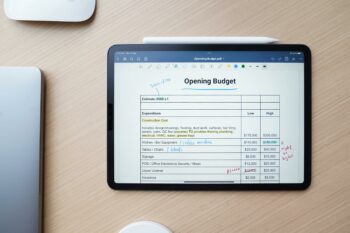Everything you Need to Know about Unit Economics
Dec 2022
To understand your company’s finances, you need to understand unit economics.
Unit economics is one particular detail that every business owner, CEO or entrepreneur should be aware of.
It’s a financial calculation that can help you become more aware of your long-term sustainability and profitability as a business. Also, when used alongside metrics such as cash flow and annual revenue, it helps you analyse your company’s performance and business future.
Let’s examine the basics of Unit Economics 101. Here's what we'll be covering:
- What is unit economics?
- The benefits of unit economics
- How to calculate unit economics
Method #1
Method #2
- Back to unit economics
- Unit economics in modern business
- Tech and SaaS startups
- Finding the balance
- Burning and churning
- Help with unit economics
What is unit economics?
Before we get to the how of unit economics, let’s examine exactly what it is; and therefore its uses within your financial modelling.
Unit economics describes your business costs and revenues for a single unit. This “unit” is assigned to whatever product or service your business produces or provides. Essentially:
How much value does each unit generate for the business?
Naturally, the “units” differ from business to business and industry to industry. Some examples of the “units” in unit economics from different businesses would include:
Airlines: Each ticket sold
Taxi company: Every ride completed
SaaS companies: Each customer
Retail: Product X (Product X = The average cost of each product in store)
Therefore, unit economics is applicable across all industries, sectors and businesses. The only item that differs is the “unit” involved. With unit economics, you can generate profitability forecasts, examine your margins and identify how much your business has to spend or save accordingly.

The benefits of unit economics
Before we explain how to calculate unit economics for your individual business, let’s cover the benefits of being able to perform and understand the calculations involved.
Forecast profits
Thanks to unit economics' advantage of providing a basic, granular picture of your profits on a single-unit basis, you can more easily identify your profit margins on each “unit” sold.
This can not only help determine how profitable your current business model is, but also when it will achieve profitability.
Pricing optimisation
Overpricing and undervaluing products are the problems behind the majority of Startups. Simply put, is your product worth what you are charging, and is it also worth what it costs to make it?
With unit economics, you can identify the soundness of a product and its pricing. You can also justify or adjust any marketing expenses attached to the “units” that you’re selling.
Assess market sustainability
Startups rely heavily upon unit economics for their ability to assess market sustainability and project into the future. How else can startups navigate their cash runway if they aren’t setting themselves up for a sustainable financial model in the future?

How to calculate unit economics
There are two methods of calculating unit economics, but we will primarily be focused on the second option, as it is the more frequently used; especially when it comes to SaaS Startups.
Which of these two methods you use to calculate unit economics will depend upon what your business classifies as one “unit”.
If a “unit” = “one item sold” then you will use the first calculation. However, if a “unit”= ”one customer” then you will opt for the second.
Method #1 to calculate unit economics
If your unit is classed as “one unit sold”, then calculating unit economics is extremely straightforward. You need to examine the revenue/cost balance using the contribution margin. This formula is:
Contribution Margin = Price per unit - Variable costs per sale
And it’s as simple as that!
If your product is sold for £150, and the variable costs of materials and sales compensation come to £70, then your contribution margin is £80.
The same applies if you want to calculate your monthly contribution margins. Simply multiply your price per unit, by the number of units sold in a month; ie. 150 x 100 = 15000.
Multiply the variable costs per sale by the number of products; 70 x 100= 7000.
Then 15000 - 7000 = 8000.
The next method is slightly more… complex.

Method #2 to calculate unit economics
In this method, unit economics is broadly defined as the ratio between two different values; Customer Lifetime Value (CLV / LTV) and Customer Acquisition Cost (CAC). However, some businesses prefer to use the CAC payback period instead.
Let’s do a terminology recap.
Customer lifetime value
Your CLV or LTV is the amount of revenue the average customer will provide to your business throughout your entire relationship. For example, a streaming service that charges an average of £10 per month and has an average customer relationship of two years will have an LTV of £240.
Sidenote: the full formula for a Customer Lifetime Value is much longer when examining real-life situations and can calculate both Predictive LTV and Flexible LTV. Both of these options are useful in different cases, but startups are more likely to use flexible LTV for their calculations due to the nature of incorporating growth potential.
The most commonly used, but still shortened version of LTV is:
LTV = Average Purchase Value x Number of Times Customer Makes Purchase x Average Length of the Customer Relationship
Customer acquisition cost
In other words, the customer acquisition cost is the amount it costs your business to acquire a new customer. This is generally through marketing efforts, but other possibilities such as free trials can also play their part.
Sales and Marketing Costs / New Customers Gained = CAC
In an extremely basic example, your company spends £10,000 per month on marketing efforts and attracts an average of 125 new customers every month. This gives you a CAC of £80.
In other words, each new customer costs you £80 to onboard.
CAC Payback Period
Your CAC payback period is essentially a calculation of the moment your customers start making you money. Let’s use our previous examples to show you a CAC payback period.
The business which charges £10 per month has a CAC of £80. If you divide the CAC by the monthly charge, you’ll see that it equals 8. So the average customer has a CAC payback period of 8 months. Once the customer has stayed with this streaming service for over 8 months, the business has covered its initial CAC.
Tech and ecommerce startup success guide
Back to unit economics
Now that we’ve covered the terminology, let’s actually cover how you can calculate unit economics by this method. It’s a simple ratio between your LTV and your CAC and it looks like this:
Unit Economics = LTV / CAC
In other words, the number of gross profits you expect to receive throughout the business relationship, is divided by how much per unit you had to lay out to get each customer. Naturally, you want your LTV to exceed your CAC by as great a margin as possible to make your unit economics viable.
If your LTV does not exceed your CAC, then your business is rapidly burning money. In fact, at this point, you are on a cash runway and the end of that runway is determined by how much capital you have left and your business decisions for the immediate future.
If your LTV matches your CAC, then you are approaching stagnation. This is still a dangerous position to be in for a business, as you lack the extra profits to expand your business and scale up.
Unit economics in modern business
With ever increasing commercial activities taking place in the cloud, estimating unit economics can be a hard task since the business lifetimes are so variable. Indeed, customer attrition rates are so high that they've taken on a new descriptor – the churn rate.
It's a very apt metaphor, as millions of customers constantly chop and change their subscriptions, cancelling or not renewing with frightening frequency as something new hits the market.
Many tech startups seem to be struggling with their unit economics and are failing because:
there's no accredited accounting system for valuing SaaS development costs
first-round valuations set the bar too high for subsequent rounds
valuations aren't relevant anyway in the world of intangible assets and IP
burn rate was too rapid
churn rates are unexpectedly high
In addition to this, more modern sectors experience vastly larger CACs compared to more traditional business models. In the USA, the Travel and Retail industries have a massively low CAC of $7 and $10 respectively. Then compare it to Tech and SaaS companies which have CACs of $395.

Tech and SaaS startups
With something as intangible as intellectual property, software and development codes, unit economics can be hard to pin down, and the above factors combined with churn rates are going to complicate any financial reporting.
Some companies are balancing overspending on sales and marketing by projecting their LTV into an unfeasibly long future so that their LTV over CAC equation makes more sense. But if you're driven to, say, a CAC of $100, then you'd have to push your LTV up to at least triple that before you could expect to make any profit at all, and to a much higher figure before you could think about any market growth.
The churn rates for most SaaS apps do not indicate that any one customer is likely to stay for two years, but unit economics are perhaps being determined by that expectation. Or that there are going to be 50 million customers in the first year so that the churn rate doesn't impact so much. Companies may also be basing their projections on reduced CAC, if their process can eventually be entirely automated, for example.
Finding the unit economics balance
There's a traditional theme that you have to spend money to make money, and many are the stories of bold tech investors who've hung on in the long term for that ultimate rags to riches success story.
Yet at the same time, many a glorious tale has been told of tech moguls pushing the boundaries of possibilities whilst financially supported by their gem-mining legacy; they simply are not applicable for everyone.
Some investors are indeed prepared to bet long on a particularly promising venture, but you might not actually get to that point. If the development costs outweigh the time investors are prepared to wait before any monetizable product is launched, then your LTV is going to be zero. And although every tech entrepreneur dreams of having a unique new product that will monopolise the market forever more, they are the exceptions that prove the rule.

Burning and churning
A burn rate is not inherently worrying if you have correctly estimated both the business valuation and the amount of time you need to produce a marketable product. However, if you burn through all your investment and then need to ask for second round funding, you're not likely to get many bites.
Alternatively, if you do produce a monetizable app but it turns out to have a high churn rate, your prospects of any long-term profits are pretty negligible. Scaling up the business will not improve matters in such a competitive market.
Your burn rate is also going to be affected by the extent of your initial capital investment. The metaphor for this is aeronautical so your burn rate is pictured as a plane speeding down your rapidly dwindling bank balance runway. If you have a short runway, a high burn rate will send you off a cliff, but if your runway is long you can afford to burn more fuel to take off.
All of these issues must be factored into a realistic assessment of unit economics and the prospects of floating your business or folding it.

Help with unit economics
If we haven’t confused you up until this point, then congratulations. Unit economics is one of the essential financial values that you need to understand, yet the variations involved that vary from business to business can confuse.
When will Variable LTV be better than Predictive LTV? Should you use method #1 or method #2? By examining unit economics versus your cash runway, what real-world applications can you perform to maintain the integrity of your Startup?
These are questions for professional financial experts.
CFOs are not only financial geniuses, they also provide real-world business guidance. More than number crunchers, these trained and experienced financial sages can draw conclusions, plot fixes and guide your business through the rockiest of financial waters.
Thankfully our teams of outsourced CFOs are available to all businesses at a level that suits you, for a fraction of the price of in-house ones. You can gain the CFO support you need, at a rate that you need it and scale up your services alongside your own business.
Get in touch with our team of CFOs to learn more about how you can benefit from their expertise and industry knowledge. Remember to check out our School of Startups, the free online database dedicated to supporting Startups with guides from professionals across every sector!
#1 finance partner for tech & e-commerce startups
- 100% online
- All in one accountancy, R&D and CFO services
- 9/10 customers recommend us

Educational content just for startups. As a member, you’ll get unlimited access to an extensive range of guides, blogs and advice to help you run and grow your business.


